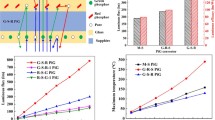Abstract
This paper presents a highly efficient and highly conductive phosphor-in-glass (PIG) material with additives for use as a white conversion component in laser-diode-driven white-light systems. Conductive additive materials such as sapphire powder were used to lessen the thermally induced degradation of the phosphor. First, the light extraction efficiency was investigated by modulating the ratio of the additive in a simulation using a light extraction model. On the basis of simulation results for the proposed PIG, both transmission-type and reflection-type sapphire phosphor-in-glass samples were fabricated and evaluated. We performed comparisons between the fabricated sapphire and glass-grit phosphors at different phosphor weight percentages. We confirmed that the sapphire powder significantly enhanced the light extraction efficiency and heat dissipation of the system. The measured light extraction efficiency coupled with the thermal effect for the reflection-type samples agreed with the simulation results.













Similar content being viewed by others
Abbreviations
- B0 :
-
Initial blue laser input
- Wn :
-
Light emitted to the top in zone n
- Wn_side :
-
Light emitted to the side in zone n
- Wn_bottom :
-
Light emitted to the bottom in zone n
- Wn_center :
-
Light emitted to the center in zone n
References
Kinoshita, J., Kawasaki, Y., Takeda, Y., & Ueno, M. (2011). 53.3: New light-bar emitting phosphor-converted white line light pumped by InGaN/GaN laser diode for edge-lit backlight unit applications. In SID symposium digest of technical papers (Vol. 42, No. 1, pp. 781–784).
Kinoshita, J., Ikeda, Y., Takeda, Y., & Ueno, M. (2012). Suppressed speckle contrast of blue light emission out of white lamp with phosphors excited by blue laser diodes for high-brightness lighting applications. Optical Review, 19(6), 427–431.
Kim, T. W., & Lee, C. M. (2015). Determination of the machining parameters of nickel-based alloys by high-power diode laser. International Journal of Precision Engineering and Manufacturing, 16(2), 309–314.
Lee, I. S., & Kim, J. G. (2014). Industrial demand and integrated material flow of terbium in Korea. International Journal of Precision Engineering and Manufacturing-Green Technology, 1(2), 145–152.
Ulrich, L. (2013). Whiter brights with lasers. IEEE Spectrum, 50(11), 36–56.
Xu, Y., Chen, L., Li, Y., Song, G., & Wang, Y. (2008). Phosphor-conversion white light using InGaN ultraviolet laser diode. Applied Physics Letters, 92(2), 021129.
Paschotta, R. (2008). Encyclopedia of laser physics and technology. Weinheim: Wiley-VCH.
Hsiao, S. L., Hu, N. C., & Cornelissen, H. (2013). Phosphor-converted LED modeling using near-field chromatic luminance data. Optics Express, 21(102), A250–A261.
Denault, K. A., Cantore, M., Nakamura, S., DenBaars, S. P., & Seshadri, R. (2013). Efficient and stable laser-driven white lighting. AIP Advances, 3(7), 072107.
Lee, D. H., Joo, J. Y., & Lee, S. K. (2015). Modeling of reflection-type laser-driven white lighting considering phosphor particles and surface topography. Optics Express, 23(15), 18872–18887.
Lee, Y., Park, S., Byun, C., & Lee, S. K. (2018). Liquid cooling of laser-driven head light employing heat spreader manufactured by 3D metal printing. International Journal of Precision Engineering and Manufacturing-Green Technology, 5(2), 295–301.
Son, J. H., & Lee, J. L. (2010). Strain engineering for the solution of efficiency droop in InGaN/GaN light-emitting diodes. Optics Express, 18(6), 5466–5471.
Liu, Z., Wei, T., Guo, E., Yi, X., Wang, L., Wang, J., et al. (2011). Efficiency droop in InGaN/GaN multiple-quantum-well blue light-emitting diodes grown on free-standing GaN substrate. Applied Physics Letters, 99(9), 031104.
Verzellesi, G., Saguatti, D., Meneghini, M., Bertazzi, F., Goano, M., Meneghesso, G., et al. (2013). Efficiency droop in InGaN/GaN blue light-emitting diodes: Physical mechanisms and remedies. Journal of Applied Physics, 114(7), 071101.
Hu, R., Luo, X., & Zheng, H. (2012). Hotspot location shift in the high-power phosphor-converted white light-emitting diode packages. Japanese Journal of Applied Physics, 51(9S2), 09MK05.
Bachmann, V., Ronda, C., & Meijerink, A. (2009). Temperature quenching of yellow Ce3+ luminescence in YAG:Ce. Chemistry of Materials, 21(10), 2077–2084.
Shi, H., Zhu, C., Huang, J., Chen, J., Chen, D., Wang, W., et al. (2014). Luminescence properties of YAG:Ce, Gd phosphors synthesized under vacuum condition and their white LED performances. Optical Materials Express, 4(4), 649–655.
Xie, R. J., Li, Y. Q., Hirosaki, N., & Yamamoto, H. (2011). Nitride phosphors and solid-state lighting (p. 81). Boca Raton: CRC Press.
Patil, S. A., Ryu, C. H., & Kim, H. S. (2018). Synthesis and characterization of copper nanoparticles (Cu-Nps) using rongalite as reducing agent and photonic sintering of Cu-Nps ink for printed electronics. International Journal of Precision Engineering and Manufacturing-Green Technology, 5(2), 239–245.
Seo, J., Kim, S., Kim, Y., & Kim, H. (2014). Effect of glass refractive index on light extraction efficiency of light-emitting diodes. Journal of the American Ceramic Society, 97(9), 2789–2793.
Kim, Y., Kim, S., Iqbal, F., Yie, H., & Kim, H. (2015). Effect of transmittance on luminescence properties of phosphor-in-glass for LED packaging. Optics Express, 23(3), A43–A50.
Acknowledgements
The work was supported by the National Research Foundation of Korea (NRF) granted by the Korea government (MSIT) (Grant No. 2018R1D1A1B07049492), Korea Evaluation institute of Industrial Technology (KEIT) Development of Core Technologies for Transportation Systems such as Green Car program (Grant number: 10070201, Development of Smart Head Lamp of VGA resolution using Micro-LED), and Institute of Intergrated Technology(IIT) Research Project through a grant provided by GIST in 2019.
Author information
Authors and Affiliations
Corresponding author
Additional information
Publisher's Note
Springer Nature remains neutral with regard to jurisdictional claims in published maps and institutional affiliations.
Rights and permissions
About this article
Cite this article
Lee, DH., Kim, S., Kim, H. et al. Highly Efficient and Highly Conductive Phosphor-in-Glass Materials for Use in LD-Driven White-Light Lamp. Int. J. of Precis. Eng. and Manuf.-Green Tech. 6, 293–303 (2019). https://doi.org/10.1007/s40684-019-00054-z
Received:
Revised:
Accepted:
Published:
Issue Date:
DOI: https://doi.org/10.1007/s40684-019-00054-z




